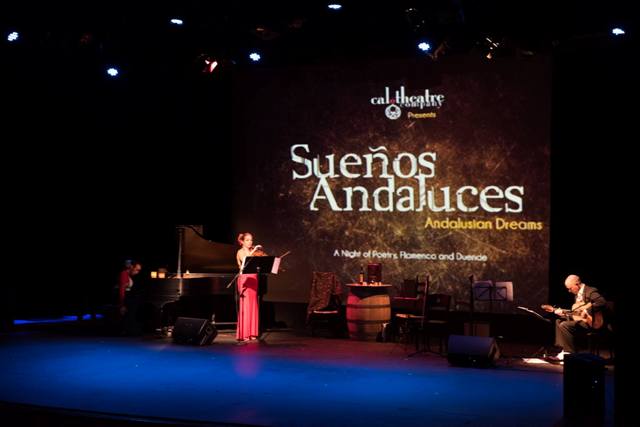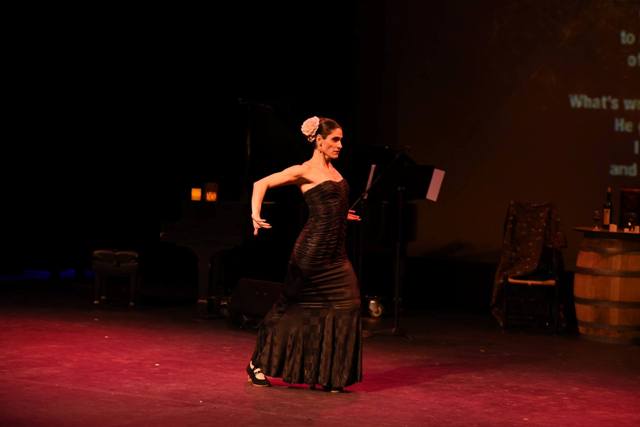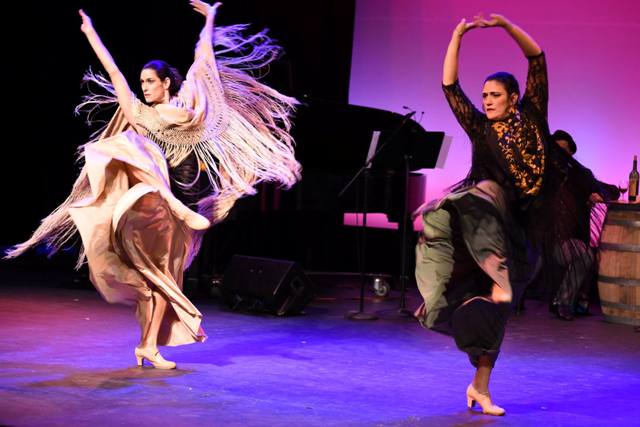The Grapevine Art & Soul Salon
Views and Reviews: Barbara Knott
Smitten with Moonlight
Y
that thrives on shallow talk and undercurrents of trickery
my sister Nancy and I drive toward Atlanta’s Marcus Jewish Community Center
where Calo Theatre Company is presenting Suenos Andaluces
of searching inward depths to find a fecund flowering: duende, what
Spanish poet Federico Garcia Lorca called the mystery, the roots fastened in the mire
that we all know and ignore. He says, All arts are capable of duende
arts require a living body to interpret them …. Poet Laureate Tracy K. Smith
reviewing Lorca, says: We write poems in order to engage in the perilous yet
necessary struggle to inhabit ourselves—our real selves, the ones we barely
to impart “something newly created, like a miracle.”
Today, Calo Gitano will celebrate flamenco, together with the poetry of Lorca
and Rafael de Leon: a weaving of words, music, and dance that will reach
and climbs and blinds us with its beauty—the main difference between them
being pace. Trees grow so slowly we can see them move only when breezes blow
or animals shake their branches. Alive with flamenco, the human body moves
then the gathering gaze that rides above striking costumes moving, to wrest from
heart and soul the mire’s mystery: duende, that makes of passion a miracle of real people
whose lives matter to themselves, to each other, and to the world beyond, within.
at the age of 38, body never to be found, though Franco is reported to have
said you “died while mixing with the rebels,” (how quietly the language of tyranny
creeps into public speech). But your death, like your life, was no accident.
but your genius runs free in the body and blood of your poetry. Leonard Cohen
caught and channeled your flow forever into song, long before he died last autumn
leaving his legacy in the wabi-sabi bowl where your light shines along with his.
YY
strange at first to be attending a flamenco performance in a Jewish community
center. How interesting later to discover that flamenco was forged in the fires
of Andalusia in Spain during the l7th and 18th centuries among Gypsies, Moors
in music and song, including traces of Indian influence. Like Maestro Manuel de Falla
Lorca locates the human voicing of deep song in the earliest musical systems
of India and in the theory that those who came to be called Gypsies
and soon appeared in European countries, notably Spain, where they refused
to merge with the larger culture, preferring the freedoms of their wandering ways.
Lorca credits the guitar with shaping a new culture: The guitar has made
drama—the struggle of the Orient and the West. Before Leonard Cohen’s life became
a concert, his musical mentoring came from a flamenco guitarist who prepared
him for Lorca’s profound impact and influence. In concert, Cohen often tells
into its images, among them a fistful of ants thrown at the sun, and the arches of Elvira
(wife of Don Juan) that were her thighs, a place of weeping. Like Lorca, Cohen
engaged in a lifelong blending of sacred and profane, essences of
among them and learned their ways. He passed through the arches and touched
Elvira’s thighs and wept, slipping away like a school of silver minnows into a place
where he invites us all to join him as he gives voice to the universe:
differences, we’re just here smitten with the moonlight.
Nancy and I want to be smitten with moonlight late on this February day in 2017
when our world seems suddenly so rickety. We will fight, not each other
have come to where we know there will be artful expressions of the duende
quest, this duel with the self, to be fought on the rim of consciousness for ourselves
and our suffering world. Ah, Lorca! Downed by a dictator but undefeated.
YYY
until I realize we are like poppies peeping above ground. That impression
of our rooted position is enhanced when Kevin Wilson drifts upstage like
the lankiest, tallest shadow you have ever seen, bringing darkness with him.
Rachel Gorwitz on viola and “Doble T” on guitar season the air with sound.
Then a piano solo, Mary Beth Morrison playing “Sevilla” from Suite Espanola.
The black grand piano is the only set piece other than a barrel table near the back
has in front of it a box that cantaor Kevin will use from time to time for drumming.
He will be joined there soon by singer Agdi “La Rosi” Sarmiento.
Poems of Federico Garcia Lorca and Rafael de Leon will be recited
on screen. Marianela “Malita” Belloso and her sister Maria Carolina “Cara” Belloso
together with the Calo Dance Company, will electrify the stage with their
tapping, stomping, snapping, swinging, circling arabesques.
In the words of T. K. Smith, The duende stirs as a way of saying you will only stay whole
by moving—day after day, note after note, poem after poem—from one word
to the next, a paradigm playing in the background of our soon-to-be rapt attention
mature, shapes a stirring song that, in Lorca’s voice, knows neither morning nor evening
mountains nor plains. It has only the night, a wide night steeped in stars.
Lorca also says that deep song is akin to the trilling of birds, the crowing
that and more as we notice how far we feel now from the city. Away from cities
(Lorca tells us), The passionate wind of poetry will blow on the dying fire, bringing
the embers to life, and these people will continue to sing: the women in the shade
of the sea. Questions arise: Did song come before language?
Did language appear first in Nature, through the imitation of birdsong, the cries
of animals, and the infinite sounds of matter?
YYYY
elements with what they themselves brought, and gave what we now call
deep song its definitive form. So it is to them we owe the creation
of these songs, soul of our soul. We owe the Gypsies the building
can escape. Behind the performers, on a screen, appear the lyrics of Rafael de Leon’s
“The Prophecy” in which pain and ecstasy come from the familiar motif
of something amiss in the lemon grove of love.
his mother. The poem opens with a maternal tribute offering poignant contrast
between loyalty and romance. Doble T’s guitar surrounds and stirs the inner life
of the poem and we are immediately in the presence of a long lament
That simple beginning opens up a flood of childhood memories
magical moments created with a girl over several years where a passion
born in a boy seemed to burn in her, too, throughout adolescence
when life became real and he learned that you are (only) worth as much as you have!
Harsh, harsh lesson for one lost in a youthful fantasy of being wed to the girl
himself. His lament leads him to a bitter prophecy:
and will call herself Coward and will see that he died young and will wake up
crying for the one who is not your husband, your boyfriend, or your lover
but the one who has loved you the most.
and her feet following the steps of the wood pigeons. So many lovely images.
Not just here but elsewhere, in Lorca’s poems as well, we will hear of the first sob
and first kiss—of tresses and thighs, moonlight, knives, blood and betrayal.
from inside as a physical/emotional response to art. It is what gives
you chills, makes you smile or cry as a bodily reaction to an artistic
performance that is particularly expressive.
YYYYY
eyes focused inward, followed soon by Malita—a duet paying dues to duende
and forcing the battle to a pitch. Malita’s fierceness evokes Lorca’s description
of the flamenco dancer who battles the air around her, air that threatens at any
will be annihilated. Both dancers are challenged to fill a dead, gray space with a living
clear trembling arabesque, one which can be vividly remembered. We watch mesmerized
by their work. Their finger talk echoes Indian classical dance where the task
a gust, a burst of creativity, individual and bold. Wearing seductive skirts and shawls
they swirl close to Nancy and me near the edge of the stage, and lo!
I look up to see that Malita’s very underarms are undulating.
where a Gypsy speaks about a trip to the river with a girl who said
she was a virgin but it seems she had a husband and, of course, we wonder
if her husband has failed her in love. The ever-chivalrous Gypsy moves
and dogs howling far away. He touches her sleeping breasts that open like hyacinth petals.
They remove clothes (including his tie and gunbelt with revolver and her four
bodices and starched petticoat) to reveal skin more smooth than seashells:
That night I galloped on the best of roadways,/ on a pearly white mare,/ without bridle,/
without stirrups. Wait! Is this Lorca or Leonard Cohen? I ask that, I realize, only
because I came to Lorca through Cohen, who thrilled to Lorca’s images
“It was only when I read, even in translation, the works of Lorca that I understood
that there was a voice. It is not that I copied his voice; I would not dare.
But he gave me permission to find a voice, to locate a voice …
existence.” Cohen built some of the poet’s images into his own work and recorded
Lorca’s “Take this Waltz” and created a cathedral where sensuality and prayer
could live together. What a wonderful tribute from master back to master!
YYYY
casually. And he didn’t. And neither do we, when we are with them.
We are treated to another maternal tribute in Lorca’s “I Will Let You Do Anything.”
Wait. The refrain is I will let you do anything/ but offend my mother …
Reciter Edwin Ortiz declares that his heart is shared between two loves
And if I find one of them crying/ it is because it was hurt by the other.
He chastises the girl for causing others to think he is a ragdoll
the rivers of my money/ go to the ocean. Reciter Clara Azcunes de Ojedo shares
the stage, listening, giving full-throated feminine responses. And we learn what may be:
that the mother forced the son to marry the girl he found on the street
his mother was young, she was forty times more beautiful than you. Embedded
in his angry tirade is another qualification: And what do I care?/ As long as you never…/
leave my side,/ I will let you do anything/ but offend my mother.
(our world) where there still is and we hope always will be—love.
Agdi “La Rosi” Sarmiento enters downstage to sing. Doble T accompanies her.
Edwin Ortiz (wearing a fetching hat) recites while Cara Belloso
expression of heaven and hell in carrying a secret love, a love that is known
and embraced by two who cannot openly embrace because he is a married man.
Yet how they love, how they dream of each other, what extravagant gestures
and runs to the child, picks him up, and like a thief in ambush,/ from his face of poppy/
my mouth bit your kiss. And then he bids the woman, no matter what happens
to keep on loving him, torment of my torments!
with saucy inset ruffles visible when they swirl. The last one flirts her way offstage
shaking her ruffle. I wonder why the dancers’ hair seems always so under control.
Is it teasing? Ready always to be unpinned by some chivalrous Gypsy?
YYY
like their adult counterparts, full of color and boldness, dressed in pink, tight long skirts
with ruffles, white tops and fringed pink necklaces, pink flowers in their hair.
I watch their eyes, intrigued to see a “come hither” look already there and waiting.
Visually stunning: he is dark and as tall as God, she is a white moon shining, their flirtation
full of seduction as well as chivalry in the hand of the man lightly caressing
the long hair of the girl whose allure leads them offstage and out of sight.
as to create a Yin/Yang configuration, perfect symbol for the creative blend and balance
of multiculturalism featured so beautifully in their performance of Lorca's Romance Sonambulo
as a song, and throughout this production of Suenos Andaluces.
published as Romancero Gitano in 1928, establishes the Gypsy notion
of the moon as a goddess who seduces and compels moon consciousness as she
shines her not-so-bright light, leaving edges of darkness where mystery
their young son alone. She performs a lascivious dance that causes him to stare
and stare until he warns the Moon to run away lest the Gypsies return and make
white necklaces and rings of her heart. She replies that when they come in
through the olive grove, bronze and dreaming,/ heads lifted/ and eyes
half closed …. Across the sky moves the moon,/ holding the young boy
by the hand. And so he goes, forever captive of the Moon, as the poet
and Rilke and Rumi and D. H. Lawrence and Leonard Cohen, among others who
understand how the sensual gives breath and sound, beauty and touch
to the sacred, and together they birth the joys and sorrows of our lives.
by Michael Meade in Why the World Doesn’t End: … the roots of renewal
are to be found in the deeper ground of living myth and genuine imagination
that sustains our connections to the joy of life and the roots of creativity.
YY
Doble T and dancers Malita and Cara and Luciana Araujo, now join forces
in rendering Rafael de Leon’s “Requiem for Federico Garcia Lorca.”
Oh! the pain and ecstasy: They killed him in Granada/ on a summer afternoon/
Lorca’s spirit disappears into the ashen skies, spilling a heart-rending sequence of verses
bloody and beautiful—no casual lamenting here. The heart and art of poetry
rise out of brutality to show—not tell, but show—Rosa of the Camborios
Her icy breasts are like two doves without beaks, wounded and stabbed ….
Of Federico we hear that the cinnamon cream/ has died! and is shrouded with lemon
and plum.The poem is full of weeping and tearing fabric, of blood and roses
the mystery of the tones and remove the precious stone of the sobs, a resonant tear
on the river of the voice. I notice how, over dancers’ hips like horses’ haunches
skirts are rippling. Then comes de Leon’s powerful cry:
into the image of a grieving dove descending to kiss the forehead of the poet
from Granada, and a leave-taking question: Where are you going, my friend/
with your secret?/ You will take with you/ voice and sonnet …/
to kill the poet in themselves or who have had their poet strangled in infancy
rise to power over the people, often with the help of sallow, sad women who
have never felt the passion that runs in blood and sap of all that lives:
for duende and for the deep song that animates authentic life and gives expression
to the soul’s need for passionate integrity. Now we want to be among those women
singing in the shade of the grapevine, waiting for night when the duende
words, believe in and perform our impossible dreams, those with roots in the Mystery.
Like Gypsies, we want to resist absorption by a culture of corruption and greed
of power hunger and perversion. Ours, too, is a struggle not to disappear.
Y
called "Madrigal." Then a burst of dancing that brings everybody back onto the stage.
we recreate our lives by dancing and singing a new world from the center of ourselves
a place where all can begin again. Today, we have seen and heard and felt
the dancing and singing. Now we long to take it home, to make it our own.
onstage. Izabel Blankenship tells of back surgery that kept her from performing and comments:
“It gives me goose bumps to watch Malita dance”—a sure sign of the duende.
She, it must be, who called
him praise. His flamenco ways are visible in the chivalrous smile, his all-white suit gleaming
in the twilight, and in the black and white polka-dotted socks worn with white shoes.
His passion is well-costumed, like the art of all who represent the Gypsy soul.
wide night steeped in stars: “They are real people. It’s good to be with real people.”



Photos by Eugenio Beltran
Notes on sources:
The passages I have quoted from Lorca can be found in his small book In Search of Duende, a New Directions Bibelot, published as such in New York, 1998, and in an article by Tracy K. Smith, “Survival in Two Worlds at Once: Federico Garcia Lorca and Duende,” at www.poets.org.
Other quotations come from Michael Meade’s book Why the World Doesn’t End: Tales of Renewal in Times of Loss (Greenfire Press, 2012), p. 180, and from Bill Plotkin’s Soulcraft Musings Facebook post of 3/31/17: “Creating a Mature Culture, a 3-part Musing,” available at his Animas Valley Institute page, soulcraft@animas.org.
Comments from Leonard Cohen were made at concerts in Antwerp (Anvers) in April 1988, in Boston during July 1993, and at his Atlanta concert that Nancy and I attended in March 2013, where his performance of Lorca’s “Take This Waltz” brought them both to a forever place in our dreams.
Recommended for your pleasure:
The setlist for the Cohen concert we attended can be found atLeonard Cohen’s Atlanta Concert
where you can listen to the songs, including "Take This Waltz"—a wonderful accompaniment for this ekphrastic piece on Calo Gitano’s Suenos Andaluces.YouTube has many samples of flamenco performances, from street and café scenes to the artful films of aficianado Carlos Suara. Here is one link:
Carlos Suara's FlamencoCopyright 2017, Barbara Knott. All Rights Reserved.